Moo Ban Chang was the first established tourist attraction in the area that offered elephants as entertainment in their natural environment. The owner, Pairat
Chaiyakham, said when starting the business some 30 years ago the roads leading to Moo Ban Chang had not yet been improved and travel was inconvenient. But today it’s an easy
journey just outside the city limits.
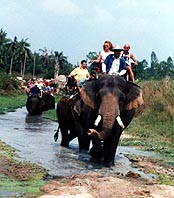 Waterways are no obstacle to these
beautiful beasts - in fact, they like it
Waterways are no obstacle to these
beautiful beasts - in fact, they like it
Visitors come from all over the world, and Pairat said that part of the attraction is that Moo Ban Chang offers a glimpse into Thai culture as well as
introducing tourists to the everyday life of the mahout and his elephant. “Tourist safety is first and foremost,” Pairat says, “as well as the welfare of the 30 elephants
employed.”
The area around Moo Ban Chang has a network of trails winding through the countryside where tourists can appreciate the clean air and natural beauty of the
surroundings, observing the agricultural lifestyle of local residents and the various types of vegetation in the countryside.
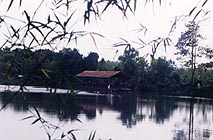 Alas, a bit too deep for our
pachyderm friends; instead it’s a relaxing ferry ride across the pond for the tourists
Alas, a bit too deep for our
pachyderm friends; instead it’s a relaxing ferry ride across the pond for the tourists
Sombat Pridsana, a likeable man who takes pride in his work, has the enviable task of welcoming the excited tourists to Moo Ban Chang. After refreshments are
served, he provides a safety briefing on elephant behavior and what to expect during the trek. The visitors then wait in anticipation at the mounting platforms as the magnificent
elephants appear, led by a large bull elephant with ivory tusks over one meter long. A short training session then begins to acquaint the newcomers to the wobbly ride ahead.
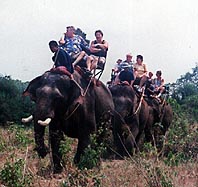 Emerging from the thick of the
jungle
Emerging from the thick of the
jungle
The trek through the countryside is a refreshing experience, as visitors take in the natural environment, complete with the sounds of birds and sights
unfamiliar to new travelers in Thailand.
Prior to completing the journey the elephants stop for water and feed on the vegetation, during which time the visitors dismount and are led by Sombat to a
forested area where medicinal plants are grown.
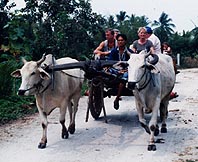 Ox carts take tourists through more
beautiful scenery on their way back to the elephant farm
Ox carts take tourists through more
beautiful scenery on their way back to the elephant farm
Moo Ban Chang maintains the exotic plants to research their various medicinal uses for elephants and mankind. Each of the plants is identified for the
visitors, who then are given an explanation of each one’s different medicinal uses.
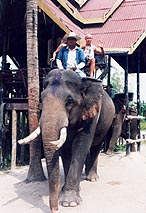 Mounting up and getting ready for
the ride of their life
Mounting up and getting ready for
the ride of their life
The visitors trek is not yet over as they are then taken on an ox cart ride after a ferry trip across the water. These carts, called “kwian” in Thai, were
once a common mode of travel 100 years ago and can still be seen in use in some remote areas, sometimes driven by cows and sometimes by water buffalo. The cart ride is about 30
minutes long and returns the group back to Moo Ban Chang.
Moo Ban Chang treks through the countryside are a unique way to see the natural environment whilst at the same time preserving it.
Moo Ban Chang is located east of Sukhumvit Road off Soi Nern Plab Wan. A few other roads in the area also lead to the site, and many have posted signs to show
the way.